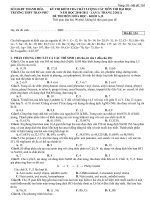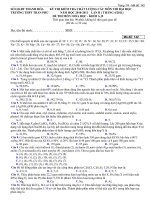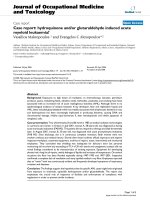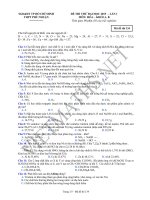CASE REPORT PHÙ REINKE KÉO DÀI BS TRƯƠNG NGỌC LỄ
Bạn đang xem bản rút gọn của tài liệu. Xem và tải ngay bản đầy đủ của tài liệu tại đây (4.35 MB, 18 trang )
CASE REPORT
PHÙ REINKE KÉO DÀI
BS TRƯƠNG NGỌC LỄ
CASE REPORT
Bệnh nhân:Nguyễn Văn..,nam,59 tuổi
ĐC : Khánh Hòa
LDĐK:Khàn tiếng
Bệnh sử:
Cách nhập viện 2 tháng,bệnh nhân khan tiếng, tăng dần ,cảm giác mệt nói
phải gắng sức .Bệnh nhân khơng tiền sử bệnh dạ dày,trào ngược ddtq,có hút
thuốc lá.Bệnh nhân đã điều trị ở nhiều BV không giảm nên đến Medic khám.
CASE REPORT
VIDEO
Reinke's edema
Reinke's edema is the swelling of the vocal cords due to fluid (edema) collected within the Reinke's space
First identified by the German anatomist Friedrich B. Reinke in 1895, the Reinke's space is a gelatinous
layer of the vocal cord located underneath the outer cells of the vocal cord.
Reinke's edema
In order for humans to produce sound for speech, the vocal folds must readily
vibrate. The two layers of the vocal cords that vibrate are the Reinke's space
and the overlying epithelium.
Accumulation of fluid within the Reinke's space alters the elasticity of the
vocal cord, making it less stiff and more gelatinous. This slows the vocal cord
vibration, which results in a deepened and hoarse voice.
The pathophysiology or mechanism of Reinke's edema is not well known,
however, chemicals contained within cigarette smoke are associated with an
increased vascular permeability of blood vessels, which results in fluid leaking
into the Reinke's space. Normally, the vocal cords are surrounded by neatly
aligned blood vessels, however, these blood vessels can become disarranged
and fragile in Reinke's edema
Causes :Smoking is the number one cause of Reinke's edema. Other factors
include gastroesophageal reflux,chronic overuse of the voice.
Signs and symptoms
List of common symptoms:
A "sac-like" appearance of the vocal folds
Hoarseness and deepening of the voice
Trouble speaking (dysphonia)
Reduced vocal range with diminished upper limits
Stretching of the mucosa (distension)
Shortness of breath (dyspnoea)
The most common clinical symptom associated with Reinke's edema is
an abnormally low pitched voice with hoarseness. The low pitch voice is
a direct result of increased fluid in the Reinke's space, which vibrates at
a lower frequency than normal .
Diagnosis
Laryngoscopy :allows the doctor to visualize movement of the vocal cord.various degrees of
balloon-like swelling of the vocal folds are seen.
Reinke's edema is characterized by a "sac-like" appearance of the vocal folds. The edema is a
white translucent fluid that causes a bulging (distension) of the vocal cord.
Based on the results of the laryngoscopy, Reinke's edema can be classified using a standardized
system set in place by Yonekawa. This system characterizes the disease based on severity.
Yonekawa Classification:
•Grade I – Lesions contact the anterior third of the vocal fold
•Grade II – Lesions contact the anterior two-thirds of the vocal fold
•Grade III – Lesions contact the entirety of the vocal fold
Treatment
The first step in treating Reinke's edema is to eliminate or control those risk
factors that are causing the disease. This includes the cessation of smoking, the
control of Gastroesophageal reflux using antacids or Proton Pump Inhibitors (PPIs),
and the discontinuation of activities that cause vocal distress.
Those experiencing a hoarseness of the voice may choose to undergo voice
therapy to improve the voice's quality and range .
If is not sufficient to improve the patient's symptoms, surgery may be required.
+The goal of surgical management of Reinke's edema is two‐fold. First, to
reduce the degenerated excess superficial lamina propria and secondly to preserve
the healthy vibratory lamina propria and epithelium.
+Surgical intervention involves making a precise excision of the edematous
superficial lamina propria while leaving some gelatinous material to ensure future
propagation of the mucosal wave
ĐIỀU TRỊ: PHÁC ĐỒ BỘ Y TẾ
BÀN LUẬN:
Đa số điều trị nội bệnh nhân khỏi bệnh.
Một số trường hợp bệnh kéo dài ,cần phẩu thuật (do phù Reinke có
thể dẫn đến nhiều biến chứng lâu dài). Bên cạnh triệu chứng khó phát
âm (suy giảm khả năng tạo âm thanh khi nói), biến chứng nghiêm
trọng nhất là tắc nghẽn đường thở ( do dây thanh bị phù nặng) ,ảnh
hưởng công việc và chất lượng cuộc sống.
Khi nào cần chỉ định phẩu thuật ,mối liên quan giữa hình thái dây
thanh qua nội soi thanh quản và chỉ định phẩu thuật ?
Vocal function in Reinke's edema--degree of the lesion
and indication of the operation.
Y Shiba 1, G Mizojiri, T Nozaki
Abstract
Fifty three cases of Reinke's edema were classified into 3 groups
according to Yonekawa's proposed classification. Of these cases, 14 were
Type I, 22 were Type II and 17 were Type III. In each case, psychoacoustic
evaluation using the "GRBAS" scale and phonatory function tests
(fundamental frequency, air flow rate, sound pressure level and maximum
phonation time) using Nagashima PS-77 phonatory function analyzer were
performed. Psychoacoustically, the voice quality before surgery was
estimated moderately impaired, in general, with high grade Roughness
accompanied by Asthenisity and Strainedness. Cases with more severe
lesions showed much worse psychoacoustic evaluation results and severely
impaired phonatoy function, but they also showed greater improvement
after surgery. Phonatory function improved significantly within a month and
psychoacoustic evaluation improved significantly from 1 to 3 months after
surgery, though neither returned to the normal range. In conclusion, we
consider that surgical therapy is appropriate in Type II and III cases, with
voice therapy and cessation of smoking also necessary for good recovery.
Reinke's edema management and voice outcomes
Karuna Dewan, MD, FACS,
1
Dinesh K.
Chhetri, MD, FACS, 2 and Henry Hoffman, MD 3
Abstract
1.6. Surgical management of Reinke's edemaInitial management of Reinke's edema usually includes
recommendation to stop smoking and undergo voice therapy. 31 , 32 , 33 When the improvement in voice is
not satisfactory for the patient, surgical intervention should be the treatment of choice. 34 Uncontrolled
LPR is associated with impaired re‐epithelialization of the vocal folds after surgical procedures for
Objectives
Reinke's edema is a chronic disease of the respiratory tract that occurs in adults with a history of chronic
smoke exposure. Also known as polypoid corditis, polypoid laryngitis, and polypoid degeneration of the
vocal fold, it is strongly associated with smoking, frequently with vocal misuse/abuse, and occasionally with
laryngopharyngeal reflux. Reinke's edema remains a cause of chronic dysphonia that is difficult to manage.
This review provides perspectives on current and future management of Reinke's edema.
Results
Reinke's edema impacts <1% of the population. The excessive mass is seen in polypoid degeneration results
in a loss of pitch control and a rough voice. Women are more likely to present for treatment as the
characteristic lowering of vocal pitch is more noticeable in women than men. Multiple grading systems have
been proposed within the literature. The current standard of care is surgical excision, after smoking
cessation. The microflap technique remains the approach of choice for bulky lesions. Surgical management
of Reinke's edema has evolved with the introduction of various lasers into otolaryngologic practice; some
which can now be used in the office setting. While many management approaches have been described
within the literature, there is a little direct comparison and no obvious superior method of Reinke's edema
management.
Conclusion
To date, the biology of Reinke's edema is not well understood. Additional research is needed further
elucidate the role of uncontrolled reflux in the development and recurrence of Reinke's edema.
Reinke's edema. 35 The goal of surgical management of Reinke's edema is two‐fold. First, to reduce the
degenerated excess superficial lamina propria and secondly to preserve the healthy vibratory lamina
propria and epithelium. However, it is important to remember that surgical intervention is the first line of
treatment when a patient presents with dyspnea, airway compromise, or respiratory distress.
Postoperatively, it is important to restore motion of the epithelial layer over the ligament as well as to
avoid development of scar. Several therapeutic modalities have been described. Surgical intervention
involves making a precise excision of the edematous superficial lamina propria while leaving some
gelatinous material to ensure future propagation of the mucosal wave. Surgical intervention may differ
based upon different surgical technique and instruments used. After surgical intervention, the inciting
stimulus should be reduced whether it is smoking, reflux, or vocal overuse. Postoperative voice therapy is
also integral in producing the best possible voice outcome. Surgical intervention for RE can be performed
with cold steel technique or with the help of a laser. The mostly commonly utilized lasers are the carbon
dioxide (CO2), potassium titanyl phosphate (KTP) laser, and 445 nm wavelength laser (blue
laser). 36 , 37 , 38Cold steel technique ; Microdebrider ; Lasers ; Injection of hyaluronidase ;
Intralesional steroid injection
Phonosurgery of Reinke's edema with microdebrider
Egle Grigaliute 1, Maria Novella Fiamingo 2, Pasquale Gianluca Albanese 2, Ignazio La Mantia 2
Abstract
Purpose: To present our experience with a new microsurgical approach for treatment of the Reinke's edema in suspension
laryngoscopy-microdebridement. After a short review of existing literature we introduce speech therapy before and after the
surgery into the protocol.
Methods: The authors compare the phonatory outcome, laryngostroboscopical results and subjective improvement of the
voice of 30 patients with Reinke's edema that were operated with either microdebridement or cold steel surgery techniques.
"Sandwich" speech therapy strategy was applied for the vocal rehabilitation before and after surgery in both patient groups.
Results: After the microdebridement and the speech therapy the mucosal wave was regular, symmetric and periodic in all
patients. No signs of abnormal scar tissue or anterior adhesions were observed. Significant improvement of vocal parameters
was found after the surgery in both groups of patients: operated with the microdebridement technique and the cold steel
technique. The subjective voice evaluated by Voice Handicap Index (VHI-10) was improved for both patient groups in a
homogenous way.
Conclusions: Based on the similarity of the vocal outcome in the two groups, microdebridement of the vocal folds is an
excellent method for removing the edema of the Reinke's space. Careful suction at a low voltage protects the lamina propria
during the microdebridement. The authors discuss the indication to this innovating procedure in patients with difficult laryngeal
exposure and small operating field.
This study also shows the preoperative state of Reinke's edema and vocal folds
morphology at different stages after combined therapy (Figure 1).
FIGURE 1. Endoscopic manifestations of Reinke's
edema. A. Preoperative; B. 1month after operation; C. 3 months after operation
VIDEO
REFERENCES
Reinke's edema management and voice outcomes.Karuna Dewan, MD, FACS, Dinesh K. Chhetri, MD, FACS
and Henry Hoffman, MD .
Tavaluc R, Tan-Geller M. Reinke's edema. Otolaryngol Clin North Am. 2019;52(4):627-635.
Noordzij JP, Woo P. Glottal area waveform analysis of benign vocal fold lesions before and after surgery. Ann
Otol Rhinol Laryngol. 2000;109(5):441-446.
Reinke’s edema: a proposal for a classification based on morphological characteristics. Marco de Vincentiis,
Massimo Ralli, Fabrizio Cialente.
Assessment of voice quality after carbon dioxide laser and microdebrider surgery for Reinke edema.Paweł
Krzysztof Burduk , Małgorzata Wierzchowska , Monika Orzechowska , Wojciech Kaźmierczak , Katarzyna
Pawlak-Osińska.
Clinical grading of Reinke's edema.Melin Tan , Paul C Bryson , Casey Pitts , Peak Woo , Michael S Benninger .
A Clinical Study of Reinke's Edema. Hiroko Yonekawa
Phonosurgery of Reinke’s edema with microdebrider.Egle Grigaliute, Maria Novella Fiamingo, Pasquale
Gianluca Albanese, and Ignazio La Mantia.
Vocal function in Reinke's edema--degree of the lesion and indication of the operation.Y Shiba 1, G Mizojiri,
T Nozaki
The Clinical Efficacy of Microsuture Technique Combined With Voice Therapy in Patients with Reinke's
Edema.Zhitao Fan, Wenxin Dong, Yabo Wang, Jinglei Fang, Xuexia Wang, Xiaolan Zhang
CÁM ƠN QUÝ THẦY CÔ VÀ
QUÝ ĐỒNG NGHIỆP ĐÃ THEO DÕI









